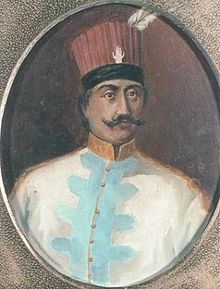Lambros Katsonis

Lambros Katsonis (Greek: Λάμπρος Κατσώνης; Russian: Ламброс Кацонис; 1752–1804) was a Greek revolutionary hero of the 18th century; he was also a knight of the Russian Empire and an officer with the rank of colonel[1] in the Imperial Russian Army (or Navy), decorated with an Order of St. George, IV class medal.
Early life[]
Lambros Katsonis was born in 1752 at Levadia, to a well-off family.[2] He was forced to flee his home in 1767, after feuding with a local Turk and killing him; at Galaxeidi he managed to board a vessel that brought him to the island of Zakynthos, then still under Venetian rule.[2]
Three years later, he went to Livorno, where the Russian fleet under Alexei Grigoryevich Orlov, sent to fight the Ottomans in the Aegean Sea, was gathering. He joined the infantry corps of Greek volunteers set up by the Russians, and distinguished himself due to his intelligence and resolve during the rest of the Russo-Turkish War of 1768–1774.[2] After the war's end, he settled in the Crimea, but soon joined the retinue of the powerful Count Grigory Potemkin. He won the esteem and support of Potemkin when he managed to assassinate an Austrian envoy and steal sensitive documents from him; as a reward, he was promoted to captain and placed in Potemkin's staff.[2]
Pirate activity[]
When the Russo-Turkish War of 1787–1792 broke out, Katsonis went to Triest, where with his own money, and through donations from the local Greek community, he bought and equipped a 24-gun warship, and began to raid Ottoman shipping.[2] This first expedition was a great success: over six months, Katsonis remained undefeated, assembling a flotilla of twelve vessels with over 200 guns. His main successes were the destruction of a Turkish pirate base at Kastellorizo, the sinking an Ottoman frigate off Rhodes, and successfully fighting off the entire Ottoman fleet east of Karpathos.[2] His actions were sanctioned by Russia; Katsonis operated under the Russian flag, and received financial support from the Russians.[2]
His fleet eventually grew to seventy vessels, which harassed the Turkish squadrons in the Aegean. In 1790 he was defeated at the Battle of Andros.[3] Katsonis had his hideout in the bay of Porto Kagio. The Algerians joined in with the Ottomans to defeat Katsonis. They cornered him at Porto Kagio and Katsonis' navy was destroyed. Katsonis escaped to Odessa and Yalta where he was granted the Livadia estate —what was later to become the Livadia Palace estate— by Catherine the Great. He lived out the rest of his days there. His wife was known as Angelina in Russia, but her real name was Maria Sophianou. He had three sons and possibly one daughter. His first son was killed by the Turks when he was still infant, in the Greek island of Kea. The second, Lykourgos (known in Russia as Ликург Ламбрович Качиони, 1790-1863), born on a Greek island, had a brilliant career as officer in the Russian Army, including his service in the Greek Battalion of Balaklava. The third son, Alexander who was born in the Crimea, also became an officer in the Russian Army. According to some sources he had a daughter named Garyfallia, but there is no information about her life.[1] One of Lambros' grandsons, Spyridon son of Alexander, was a known Russian writer. He was also the godfather of Odysseas Androutsos, a commander of the Greek War of Independence.
The Livadia Palace, the summer home of the last Tsars was built on Katsonis' Livadia estate after 1861. The name of the estate was given to it by Katsonis, who named it after his birthplace; moreover, this is the origin of the name of Livadiya town itself.[1] It is there that the World War II Yalta Conference took place.
The Hellenic Navy has named four of its ships after Katsonis.
References[]
- ^ Jump up to: a b c Panos Stamou (c. 2007). Προσέγγιση ιστορικής προσωπικότητας μέσα από Αρχειακές πηγές: Περίπτωση Λάμπρου Κατσώνη [Approaching the historic person through archival sources: The case of Lampros Katsonis] (DOC) (in Greek). Hellenic Cultural Center (Moscow). p. 6.
- ^ Jump up to: a b c d e f g Aspreas 1929, p. 103.
- ^ Dakin, Douglas (1973). The Greek Struggle for Independence, 1821–1833. Berkeley: University of California Press. pp. 26–27. ISBN 0-520-02342-0.
Sources[]
- Aspreas, G. (1929). "Κατσώνης Λάμπρος". Μεγάλη Στρατιωτικὴ καὶ Ναυτικὴ Ἐγκυκλοπαιδεία. Tόμος Τέταρτος: Καβάδης–Μωριάς [Great Military and Naval Encyclopaedia. Volume IV: Kavadh–Morea] (in Greek). Athens: Ἔκδοσις Μεγάλης Στρατιωτικῆς καὶ Ναυτικῆς Ἐγκυκλοπαιδείας. pp. 103–104. OCLC 31255024.
- Pryakhin, Yuri D. (2004). Ламброс Кацонис в истории Греции и России [Lambros Katsonis in the history of Greece and Russia] (in Russian). St. Petersburg: Aletheia. ISBN 5-89329-731-8.
- Vakalopoulos, Apostolos (1975). "Η στροφή των Ελλήνων προς τους Ρώσους: Ο Ρωσοτουρκικός πόλεμος του 1787-1792 και οι Έλληνες. Οι αγώνες των Σουλιωτών και η δράση του Λάμπρου Κατσώνη" [The Greeks turn to the Russians: The Russo-Turkish War of 1787–1792 and the Greeks. The struggles of the Souliots and the actions of Lambros Katsonis]. In Christopoulos, Georgios A. & Bastias, Ioannis K. (eds.). Ιστορία του Ελληνικού Έθνους, Τόμος ΙΑ΄: Ο Ελληνισμός υπό ξένη κυριαρχία (περίοδος 1669 - 1821), Τουρκοκρατία - Λατινοκρατία [History of the Greek Nation, Volume XI: Hellenism under Foreign Rule (Period 1669 - 1821), Turkocracy – Latinocracy] (in Greek). Athens: Ekdotiki Athinon. pp. 85–97. ISBN 978-960-213-100-8.
- 1752 births
- 1804 deaths
- Eastern Orthodox Christians from Greece
- Greek pirates
- Greek revolutionaries
- People from Ithaca
- 18th-century Greek people
- People from Livadeia
- 19th-century pirates
- Recipients of the Order of St. George
